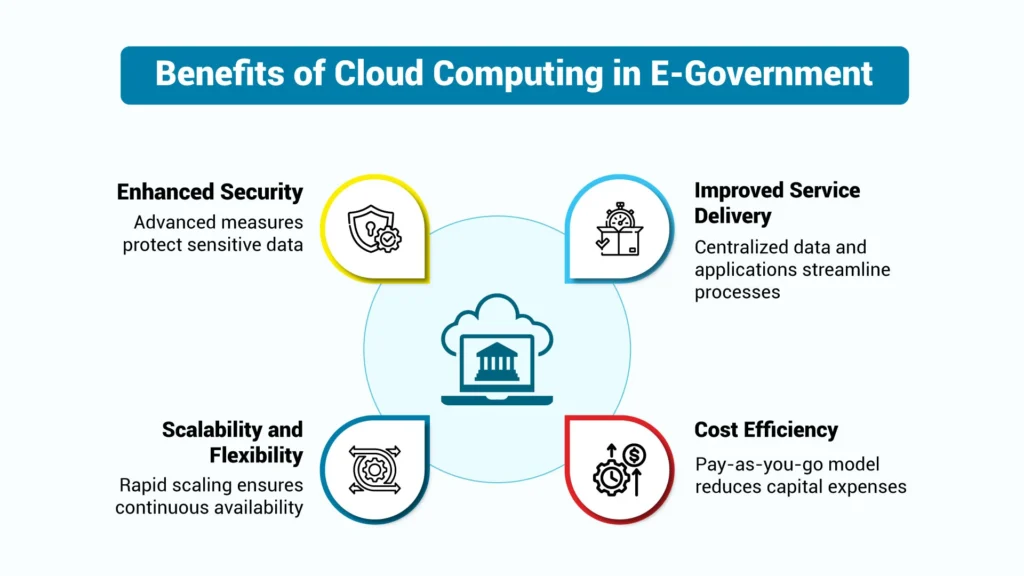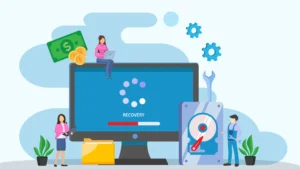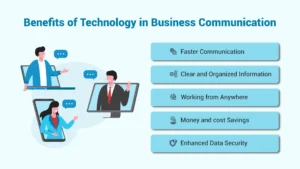E-government services, like renewing your driver’s license online or accessing public records, have become a regular part of modern life. These digital platforms are more than just conveniences; they’re part of a broader shift known as electronic government, where public services are delivered through digital means to improve access, efficiency, and citizen engagement.
At the center of this transformation is cloud computing. It’s what allows governments to store and manage huge volumes of data without relying on outdated, maintenance-heavy systems. With cloud environments, public agencies gain flexibility, save on infrastructure costs, and scale up their operations as needed. Perhaps more importantly, they get enhanced security and centralized control, two essentials for handling sensitive information responsibly.
But what role does cloud computing play in e-governance, exactly? It’s foundational. It makes it possible for governments to streamline services, reduce bureaucracy, and provide faster, more responsive interactions with citizens. In other words, cloud computing isn’t just supporting e-governance, it’s driving it forward. And as demand for digital services grows, its role is only set to expand.
Key Benefits of Cloud Computing in E-Government Services
Cloud computing in government, often referred to as e-government computing, is reshaping how public services are delivered. Its benefits are broad and impactful, touching nearly every aspect of administration and citizen interaction.

One of the most immediate advantages is improved service delivery. By centralizing data and applications in the cloud, governments can cut down on paperwork, eliminate redundant processes, and offer faster, more streamlined responses to public needs. Tasks that once took days or even weeks can now be handled in a matter of minutes. That kind of efficiency doesn’t just save time, it improves trust and satisfaction among citizens.
Then there’s the cost efficiency. Traditional IT infrastructure can be expensive to maintain, requiring regular upgrades, physical space, and dedicated personnel. Cloud services reduce those capital expenses significantly. Governments can operate on a pay-as-you-go model, allowing them to allocate resources more wisely and focus spending where it’s most needed.
Scalability and flexibility are other key strengths. Public service demands aren’t static, emergencies, natural disasters, or even just election season can spike usage. Cloud platforms allow for rapid scaling up or down, ensuring continuous availability without service slowdowns.
Lastly, there’s enhanced security. Leading cloud providers offer advanced security measures, from encryption to multi-layered firewalls and real-time threat detection. For governments handling everything from health records to tax data, this level of protection is not just beneficial, it’s essential.
Altogether, these benefits make cloud computing a natural fit for e-government. It doesn’t just modernize services, it makes them smarter, safer, and more in tune with the expectations of today’s citizens.
Enhancing Security and Compliance in Cloud-Based Government Systems
When it comes to e-government services, security and compliance aren’t just technical checkboxes, they’re fundamental to earning and keeping public trust. Citizens are handing over personal, sometimes highly sensitive information, from health records to tax details. If that data is compromised, the fallout isn’t just digital; it’s political, social, and deeply personal.
This is where cloud computing proves its worth. Unlike traditional systems, cloud environments are built with security in mind from the ground up. Features like end-to-end encryption, multi-factor authentication, and tiered access controls help protect data at every stage, whether it’s being stored, processed, or transferred. And because cloud providers constantly update their platforms to counter emerging threats, government agencies don’t have to manage security alone. They benefit from a shared responsibility model that includes expert-built defense mechanisms.
But securing data is only half the story. Governments must also comply with a maze of data protection regulations, HIPAA, GDPR, and others depending on the jurisdiction. Fortunately, many cloud service providers design their platforms to meet or exceed these global standards, making it easier for public institutions to stay compliant without building everything from scratch.
Additionally, most cloud systems come equipped with real-time monitoring, auditing tools, and automated incident response features. That means potential breaches are not only detected quickly but can be mitigated before serious damage occurs. This proactive approach, catching problems early, responding fast, is critical in today’s cyber-threat landscape.
In short, cloud computing doesn’t just support e-government operations, it safeguards them. It provides the infrastructure and tools needed to protect citizen data while meeting the legal and ethical demands of modern governance. And as digital services expand, the importance of secure, compliant cloud systems will only continue to grow.
Real-World Applications and Case Studies
To truly grasp the impact of cloud computing in e-governance, it helps to move beyond theory and look at how it’s being used on the ground. From healthcare to city management, real-world applications are showing just how transformative cloud technology can be.

Expert Perspectives:
Dr. Elena, Director of a Regional Healthcare System, explains, “Implementing cloud-based solutions has revolutionized our patient data management. Real-time access to information has significantly improved how quickly and accurately we treat patients.” Her experience highlights how cloud computing isn’t just about efficiency, it’s about outcomes that directly affect people’s lives.
Carlos, an IT Manager for a mid-sized municipal government, adds, “Migrating our systems to the cloud cut down our costs and gave us the flexibility to scale. It’s also made our public services faster and more accessible.” His insight shows how even local governments can benefit substantially from the shift.
Real-World Case Studies:
Estonia, often considered the gold standard for e-governance, uses cloud computing for services like e-residency, digital ID, and even online voting. This approach has made the government more transparent and accessible while enhancing public trust.
Another example is AWS’s role in public sector innovation. Projects like deploying telehealth systems with the U.S. Army demonstrate the flexibility and power of cloud infrastructure in high-stakes environments.
In the U.S., cloud.gov offers federal agencies a secure, compliant cloud platform designed specifically for government applications. It simplifies adoption, enabling faster deployment of citizen-facing digital tools.
These stories aren’t just successes, they’re blueprints. They show how cloud computing can be thoughtfully applied to create smarter, more responsive public services. As more governments follow suit, the cumulative impact could reshape how entire populations interact with their institutions.
What Role Does Cloud Computing Play in E-Governance: The Challenges and Considerations
While cloud computing has opened up new frontiers for digital governance, it doesn’t come without its share of complications. As more governments shift toward cloud-based infrastructures, the challenges, though manageable, need to be acknowledged and thoughtfully addressed.
Vendor Lock-In is a primary concern. Once a government agency commits to a specific cloud service provider, switching can become both technically and contractually difficult. Proprietary software, custom configurations, or data migration complexities may lead to long-term dependence, reducing flexibility and potentially increasing costs over time.
Infrastructure Limitations also play a significant role, especially in developing regions. Without reliable internet connectivity or the necessary IT infrastructure, even the best cloud solutions may fall short. Add to that the limited financial resources of some public institutions, and the full promise of cloud adoption remains out of reach for many.
Security is another crucial issue. While cloud platforms are often more secure than legacy systems, the risk of cyber threats persists. Governments handle sensitive citizen data, and even a minor breach can erode public trust. Maintaining strong security means constant vigilance, updates, and incident response capabilities.
Finally, Compliance with the Electronic Government Act and other regional regulations adds another layer of complexity. Public agencies must navigate legal frameworks carefully to ensure data privacy, transparency, and ethical use.
To fully harness the benefits of cloud computing in e-governance, these obstacles must be tackled head-on, with clear strategy, strong governance, and a willingness to adapt over time.
Practical Tips for the Implementation Framework in E-Governments
Implementing cloud computing within an e-governance framework isn’t just a technical task, it’s a strategic shift that demands thoughtful planning, stakeholder coordination, and a continuous feedback loop. A successful transition starts with a clear, well-defined strategy. Governments should outline their goals, evaluate current infrastructure, and determine which services are best suited for migration to the cloud. This foundational step helps avoid costly missteps down the line.

Once the vision is set, governance in cloud computing becomes essential. This means developing comprehensive policies around data security, user access, and regulatory compliance. Clear procedures help ensure that sensitive public data is handled consistently and transparently.
Stakeholder engagement is another key piece. Effective e-governance depends on more than just IT teams, it involves agency heads, system users, and even citizens. Inviting input early on helps tailor solutions to real-world needs and boosts buy-in across the board.
Of course, even the best systems fall flat without the right skills behind them. Investing in training ensures that staff can manage, troubleshoot, and evolve cloud platforms confidently.
Finally, monitoring and evaluation shouldn’t be an afterthought. Establish performance benchmarks and gather feedback regularly to refine processes and measure impact. This cycle of review supports continuous improvement, helping governments stay responsive and efficient.
By approaching cloud implementation with this framework in mind, public agencies can navigate complexity while staying focused on the ultimate goal: better, faster, more secure digital services for everyone.
The Future of Cloud-Driven E-Governance
The future of cloud-driven e-governance looks both dynamic and promising. As digital transformation accelerates across the public sector, cloud computing will remain at the core of how governments modernize services and connect with citizens.
Emerging technologies, especially artificial intelligence and machine learning, are set to elevate the capabilities of cloud platforms even further. These tools can automate complex processes, offer predictive analytics, and personalize services in ways that weren’t possible a decade ago. Imagine public systems that respond faster, anticipate needs, and continuously improve, powered quietly behind the scenes by cloud intelligence.
At the same time, more governments are shifting toward hybrid and multi-cloud strategies. This approach allows them to spread workloads across different environments, increasing operational flexibility and reducing risk. It’s like having a safety net for critical infrastructure.
In the long run, cloud computing won’t just support e-governance, it will actively shape its evolution. From data-driven policy decisions to real-time citizen services, the cloud opens the door to a future where public systems are more responsive, inclusive, and secure. Trust will grow, participation will rise, and the relationship between citizens and their governments will become smarter, and maybe a little more human.
Final Thoughts
Cloud computing isn’t just a tool in the e-governance toolkit, it’s the foundation of a smarter, faster, and more accessible public sector. It enables governments to move away from paper trails and red tape toward seamless, citizen-first digital services. With it, service delivery improves, costs shrink, data scales effortlessly, and security tightens, all without the heavy lifting of outdated infrastructure.

But this transformation doesn’t come without its share of hurdles. From data privacy concerns to integration challenges, the journey to cloud-powered governance requires foresight, strategy, and a willingness to adapt. Still, the potential rewards far outweigh the risks.
What role does cloud computing play in e-governance? It’s not just a technical question, it’s a strategic one. For policymakers, it means rethinking how governments operate. For IT leaders, it’s about building agile, resilient systems. And for everyday citizens, it’s the difference between waiting in line and clicking “done” from a smartphone.
The digital shift is already underway. Governments that embrace cloud computing today aren’t just upgrading technology—they’re rewriting the future of public service. The stakes are high. But so is the opportunity to create a more transparent, efficient, and citizen-centered world.










